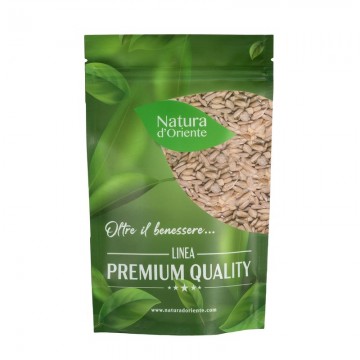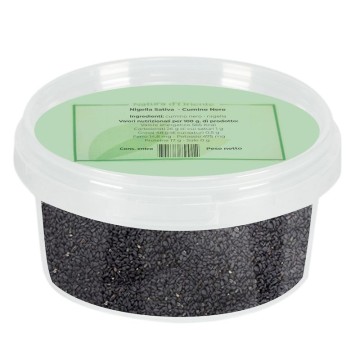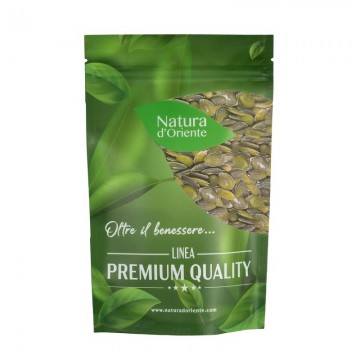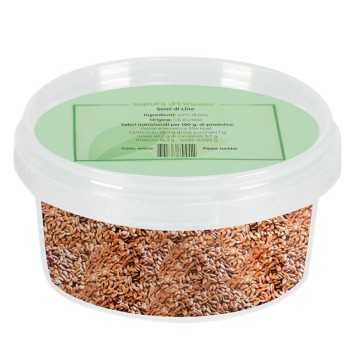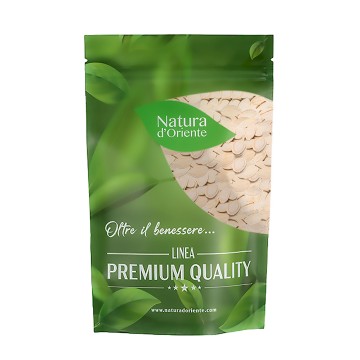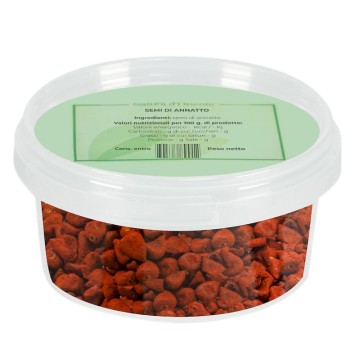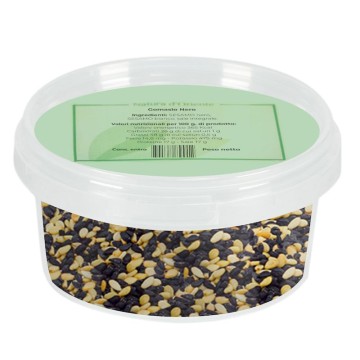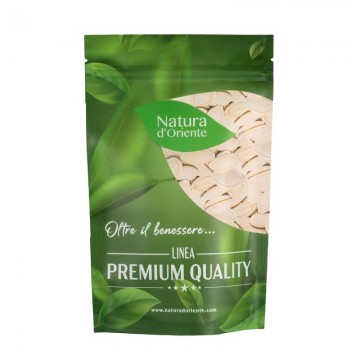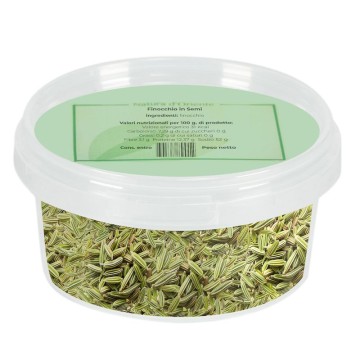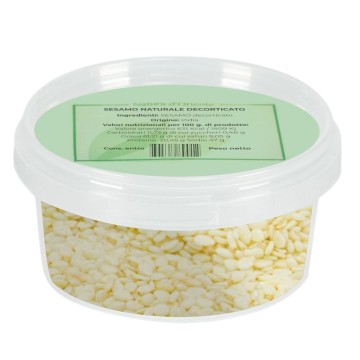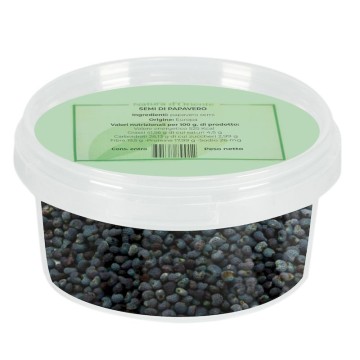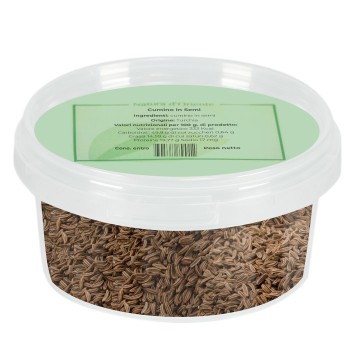These oil seeds are a natural and whole variety, already toasted, ready to be used as a decoration after cooking, for seasoning salads and other dishes. Natural sesame, with the peel intact, maintains its golden and brown hue (unlike the ivory white peeled sesame). These seeds are a widespread ingredient in all world cuisines, appreciated for their taste and for the richness of nutrients they provide. In recipes they give a delicate flavor and add a light note of hazelnut, much appreciated in Asia and the Middle East, both in sweet and savory dishes. In Western cuisine, they are most commonly used raw in the diet as a snack, to flavor salads or to add “good” fats to recipes.
What are the properties of brown sesame seeds?
The “whole” seeds that are not peeled maintain their nutritional properties at their best, especially with regard to the compounds present in the outer skin. These natural sesame seeds therefore have excellent beneficial properties thanks to the substances they contain, ranging from antioxidant polyphenols to mineral salts, vitamins, fibers, fatty acids and other nutrients. Their richness is useful for a supporting and restorative action on the body, effective for maintaining a state of well-being and improving it through proper nutrition. From the point of view of nutrients, natural brown sesame seeds provide precious mineral salts and trace elements. In particular, they are a good plant source of calcium, and contain magnesium, manganese, iron, selenium, copper and zinc. These are important nutrients for the proper functioning of the metabolism, cells and immune system; useful for the circulation of oxygen in the body. Other valuable components in these seeds are folic acid and B vitamins, vitamin E and a good presence of proteins. They contain fiber and important fatty acids (oleic acid, linoleic acid, palmitic and stearic acid); these healthy fats help reduce cardiovascular risk by controlling LDL cholesterol levels in the blood and increasing "good" HDL cholesterol. Unhulled sesame seeds are considered beneficial for cardiovascular health also thanks to their content of lignans; antioxidant polyphenols present in the outer shell. These plant compounds help regular blood circulation and the well-being of the cardiovascular system. At a digestive level, the consumption of natural brown sesame seeds can contribute to the correct assimilation of food: they combat constipation thanks to their richness in fiber and help the development of healthy intestinal bacterial flora. In the kitchen, these natural sesame seeds are one of the best foods in the macrobiotic diet. In addition, they are a tasty and healthy alternative for those who cannot consume dairy products and milk derivatives. In addition, sesame seeds contain nutrients that are useful for the well-being of hair and skin. In fact, sesame oil is obtained from them and is used for cosmetics, to perform invigorating massages and to combat dandruff.
Contraindications of natural sesame seeds
These oil seeds are generally considered safe for consumption, but it is necessary to moderate their intake to avoid unwanted effects. Excessive consumption of natural sesame seeds could cause digestive problems due to the presence of fiber and the peel (not removed). Conditions of stomach pain, abdominal swelling and excess gas may occur. Like many seeds, they are not recommended for those with allergies or difficulty digesting nuts and seeds.
Buy our natural brown sesame seeds
These unhulled seeds are a natural version of many available varieties, often produced with additional elements. Those looking for toasted and untreated sesame can find it more easily in specialized spice shops such as Natura d'Oriente. You can buy natural brown sesame seeds online in our e-shop, selected for their high quality and nutritional value. Our packs contain loose sesame seeds, available in a variable weight between 75 g, 100 g, 150 g, 250 g, 500 g and 1 kg, with a convenient price. We put the spices in airtight freshness-saving packages, for better preservation in the pantry.
How to use natural sesame seeds in the kitchen?
These toasted seeds keep their outer shell, and are ready to be added to recipes to garnish or flavor. They give a sdelicate, almost neutral aroma but with nutty notes, intensified by the toasting. As “whole” sesame seeds, they can be added to recipes either whole or ground on the spot, depending on the needs of the recipe and creativity in the kitchen. Together with other oil seeds, they can be used as garnishes to maintain nutrients, especially in salads, on cold dishes or in sauces without cooking; they are sprinkled on dishes at the end of cooking. Alternatively, they can be ground, crushing the natural brown sesame seeds with a mortar and pestle, or using a spice grinder. Grinding on the spot, just before adding to dishes, ensures that the aromatic profile and nutritional values are maintained. Since the numerous fats in sesame tend to go rancid in the air, the spice should be used immediately after crushing. The whole seed version, on the other hand, keeps well for a long time at room temperature. Grinding natural sesame seeds is also useful for better absorption of nutrients (fats and vegetable proteins). It prevents the outer shell of these “whole” seeds from resisting the acids of digestion, and helps release each compound. In any case, it is useful to chew the seeds to better assimilate the substances enclosed in the shell and in the shell itself.
How to use toasted sesame seeds?
Savory recipes: they are included as a finishing touch in first and second courses, to give a pleasant aroma that is very reminiscent of Middle Eastern and Asian cuisines (Chinese, Japanese and Korean). In many recipes, natural sesame seeds are excellent for flavoring raw soups and dishes based on pan-fried, grilled or boiled vegetables. They can enhance tofu and Asian noodle and rice dishes with a finishing touch; they are used raw as an addition to sprinkle on salads and cold dishes. Meat and fish: This version of toasted sesame seeds is used to sprinkle raw on meat and fish dishes, in sushi or sesame salmon rolls. Sweet recipes: Sesame seeds infuse desserts with a nutty flavor and are delicate in creams and desserts to be prepared without cooking. They can flavor yogurt, smoothies, centrifuges, kefir, plant-based milk and fruit salads. They provide a nutritious addition to muesli and breakfast cereals. They are used in various exotic pastry recipes and among the famous ones are the Arab sweets halva, based on crushed and sugared sesame seeds. Sauces: These unhulled seeds are used in Middle Eastern cuisine for the preparation of tahini and hummus. Always toasted and then ground, natural sesame seeds create a base for creamy and tasty seasoning sauces. They can be processed by including honey or sesame oil, obtaining a sweet and salty aroma. Sesame can flavor butter, oil and join other spice and seed mixtures. Toasted seeds can create gomasio, a traditional Japanese condiment made from black and white sesame seeds.
The Recipe: Asian Salad with Noodles, Almonds and Sesame
Ingredients
: 100 g of noodles (or ramen noodles) - 2 tablespoons of butter - ½ cup of flaked almonds - 2 tablespoons of natural sesame seeds - 1 cup of shredded cabbage - 1/2 cup of shredded lettuce - 1/2 cup of thinly sliced green onion - 1/2 cup of olive oil - 1/4 cup of white vinegar - 1/2 cup of white sugar - 2 tablespoons of soy sauce - coarse salt to taste – 1 pinch of pepper - 1 teaspoon of water
Preparation
Start by preparing the dressing. In a jar with an airtight lid, combine the ingredients: vinegar, sugar, oil, water, soy sauce, salt, pepper. Shake well until the sugar dissolves. Place the noodles in a plastic bag and crush them with a rolling pin or spatula. Cook the noodles in boiling water, according to the time indicated on the package. Remove them and cool them under cold water, to stop the cooking. Place them in a bowl. Meanwhile, melt the butter in a large skillet over low heat. Once the butter has melted, add the noodles to the pan, and toss everything together, stirring often. Remove from heat, add almonds and sesame seeds and let the aromas spread. Place on a plate, to cool. Shred the cabbage and combine with the onions in a large salad bowl. Add the mixture to the noodles. Pour the dressing from the jar over the salad and toss well to coat. Serve immediately.
Origins and History of Sesame Seeds
They come from the Sesamum indicum plant, which is part of the Pedaliaceae family. It can produce different types of oily and flat seeds, which grow in pods with various colors (white, red, gold, brown, black, etc.) - of which the white variety is very common. It is a plant native to the tropical area, Asia or East Africa; in fact the term indicum highlights its origins from India (by extension from the East). Historically, it is a plant known for thousands of years and is still cultivated today in many corners of the world, appreciated for its properties. We know that the ancient Egyptians used ground sesame seeds as cereal flour, but they also introduced it for nutritional and therapeutic purposes. In the Ebers papyrus (ca. 1550 BC), with the term semsent, it was considered a remedy against headaches and hemorrhages. In China and India the seeds were known as a condiment, ground and mixed with food. They were considered beneficial for their natural medicinal properties and, moreover, they were used for ritual and cosmetic purposes. An oil was obtained from them that was useful as fuel for lamps. Because of its versatility, Indian literature attributes the origin of sesame to the gift granted to humans by the gods: according to mythology, sesame seeds were born from the drops of sweat of Vishnu. In Indian culture, the importance of sesame is reported in Ayurvedic Medicine, where the seeds represent stimulants for digestion and natural cures for the genitourinary system. In the sacred Buddhist texts, sesame is considered a superior food, an essential part of the monks' diet. Buddha remembered that "the sesame seed, despite being very small, could generate a large tree". Magical powers were attributed to this plant, and even today we remember the formula "Open Sesame", taken from a story in the Thousand and One Nights; Ali Baba used it to open the rock of a cave full of hidden treasures. The phrase recalls the opening of the Sesame fruit, which contains seeds rich in nutritional and restorative properties - a "treasure" that gives strength and vitality. In our country, sesame arrived on the table in Roman times, when they began to spread, particularly in Sicily where the seeds were sprinkled on bread. The Romans ground sesame seeds with Roman cumin, to obtain a spicy condiment. Today, sesame seeds are very common in Africa and in Mediterranean countries, appreciated together with raw honey, with which sesame cakes are prepared.

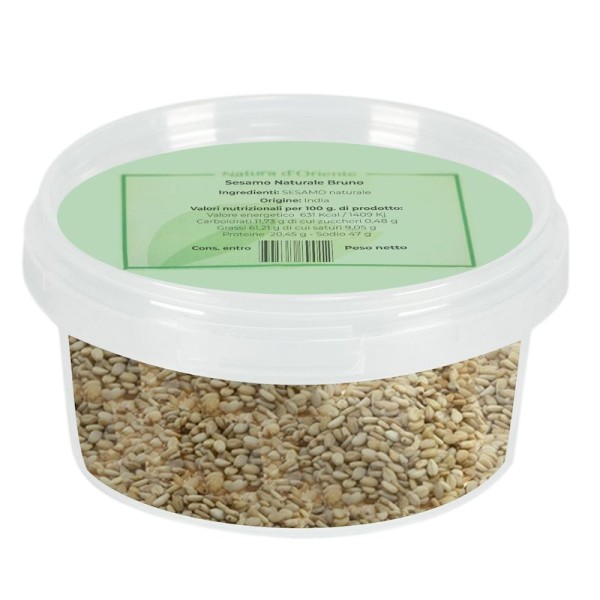







 No reward points for this product.
No reward points for this product.

